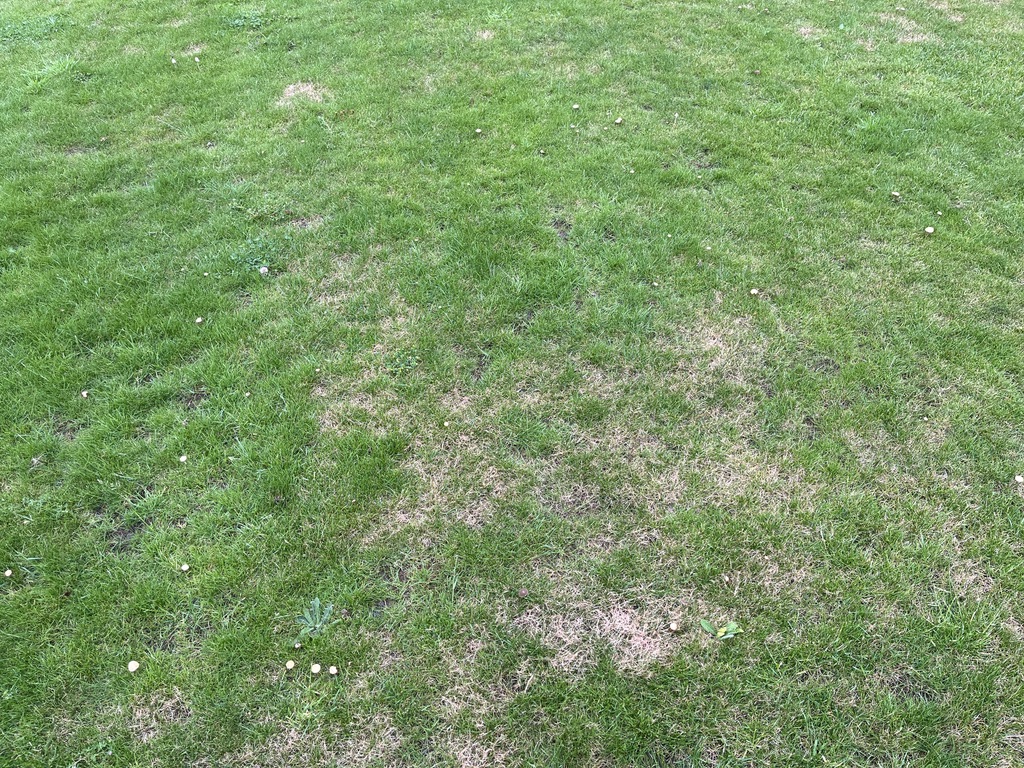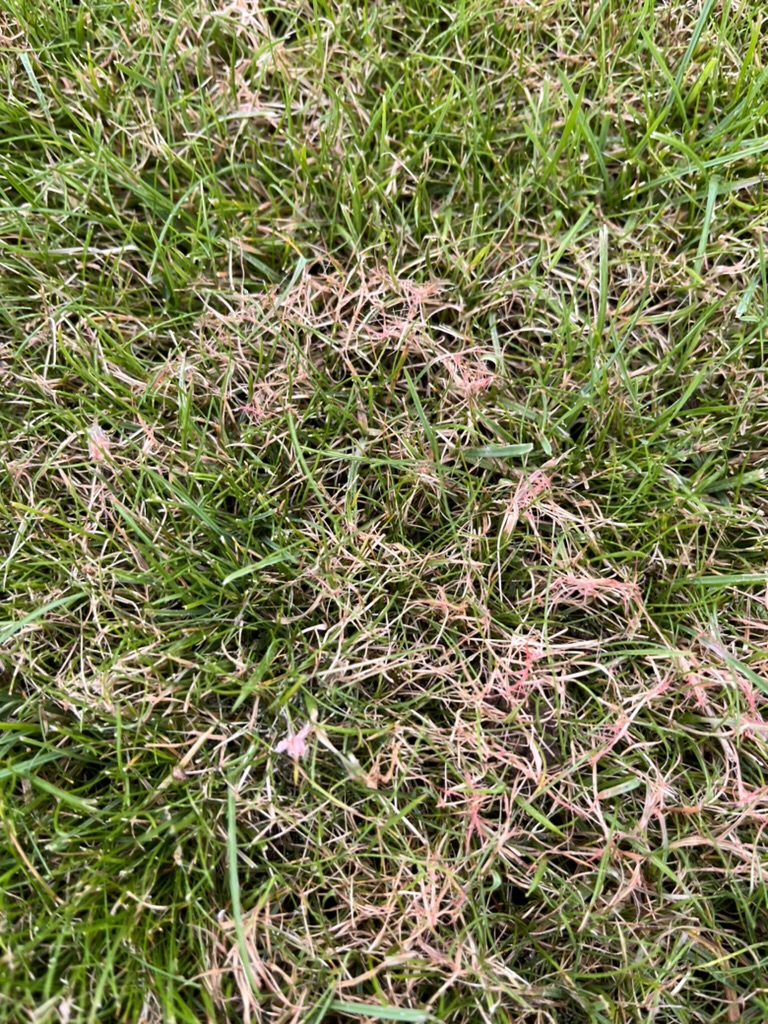Understanding and Managing Red Thread in Lawns
22 August 2024
(Last updated: 22 Aug 2024 15:18)
Red Thread disease is unsightly, but it’s not the end of the world. In this article we’ll explain what causes Red Thread disease, how to identify it, how to restore your lawn from Red Thread Damage and how to minimise the risk of its return.
What Causes Red Thread Disease?
 Red Thread disease is caused by a type of fungus called Laetisaria fuciformis. Low levels of pathogenic microorganisms are ever-present in the environment. It’s only when the conditions are just right for a fungus to reproduce and breed, that the population grows enough for it to becomes a nuisance.
Red Thread disease is caused by a type of fungus called Laetisaria fuciformis. Low levels of pathogenic microorganisms are ever-present in the environment. It’s only when the conditions are just right for a fungus to reproduce and breed, that the population grows enough for it to becomes a nuisance.
Like most fungi, Laetisaria fuciformis loves warm wet conditions. This particular microorganism also loves lawn grasses. In summer and autumn, it’s not unusual for lawns to develop at least one or two patches of Red Thread disease. To manage this disease effectively it’s important to understand its likes and dislikes. With understanding comes the ability to build a lawn-care regime to guard against the dreaded Red Thread.
How To Identify Red Thread Disease
Viewed from a distance, Red Thread appears as irregularly shaped patches of discoloured grass. These patches are generally straw coloured with a pinkish tinge. The grass will sometimes appear bleached. But unlike urine scorch, there is no darker green border to the patch.
pinkish tinge. The grass will sometimes appear bleached. But unlike urine scorch, there is no darker green border to the patch.
When you get up close and take a good look at Red Thread disease it’s easy to see where it’s name comes from. Small pinkish-red structures will be visible on the blades of grass. Each one looks like a tiny piece of sewing cotton. Hence the name Red Thread.
If you have one, it’s worth looking at Red Thread disease through a magnifying glass. It might be making your lawn look ugly, but those little structures are really quite beautiful.
Red Thread only affects the leaves. It does not attack grass roots, so you can be confident that over time, your lawn will recover from this disease.
How To Treat Red Thread Disease
Contain the disease
- You cannot prevent fungal spores being spread by wind or rainwater, but you can avoid carrying them around the garden on shoes and tools.
- When mowing, try to tackle the healthy lawn sections before going over the diseased patches.
- Collect all clippings and dispose of them. Please don’t put affected vegetation on to the compost heap, you’ll only be storing up trouble for the future.
- After cutting, disinfect the mower blades and the underside of the machine.
- Avoid stepping on affected areas.
Feed Your Lawn
UKLCA lawn care specialists report that lawns where the soil nutrient levels are sub-optimal are more prone to Red Thread damage than well fed lawns. Applying a seasonally appropriate feed will therefore speed the recovery process.
More often than not, Red Thread will cease its activity as soon as the weather changes. Some nice dry days, or a drop in temperature usually do the trick. However Red Thread will leave ugly scars on your lawn. More on that later.
If All Else Fails
If Red Thread is particularly persistent in your lawn, or if the disease seems to be spreading out of control, your local lawn care professional may be able to apply specialist chemicals. These are not normally available through garden centres and can only be applied by trained operatives.
A Note About Red Thread And Soil Types
Anecdotal evidence from members of the UK Lawn Care Association (UKLCA) suggests a distinct link between certain soil types and the frequency and persistence of Red Thread Disease.
Jim Hewlett, UKLCA Vice Chairman says “We find in most cases where a lawn suffers from persistent RT it comes down to the quality of the soil causing the lawn to be vulnerable. Lawns which are on hungry or inert soil tend to suffer more badly from persistent red thread than those lawns on good quality soil, the same can be said for lawns which are grown on soil which has a very high or low Ph which tends to “lock-up” the nutrient which has been applied. We recommend that in the cases of severe and persistent RT that laboratory soils tests are done to see if there is deficiency or imbalance in the soil that could be adjusted with specialist chemical or mechanical treatments. Understanding the soil tends to make it much easier to understand why grass turf is unhappy."
Restoring Lawns from Red Thread Damage
Red thread does tend to leave unsightly scars on a lawn. However, the good news is that it doesn’t affect the plants’ roots. Your grass will recover over time.
You can speed up recovery by creating conditions that encourage rapid, healthy grass growth but don’t encourage the return of Red Thread (or any other fungal lawn diseases).
We’ve already mentioned feeding your lawn and boosting plant vigour with lawn treatments. But of course plants need water too.
Irrigating your lawn will support speedy growth but could also create the damp environment so beloved of fungal lawn diseases. If you decide to irrigate, it’s better to water in the morning, and apply plenty of water so that the roots get a good soaking but surface water is quickly evaporated by the sun. Watering deeply and infrequently is altogether better for plants and soil.
Excess thatch and soil compaction will both impede drainage and could lead to water sitting on the surface of the lawn rather longer than is helpful. Scarification and aeration will alleviate problems but please take expert advice before trying either of these in summer time.
Proactive Lawn Care: Mitigating Red Thread Risk
Just like us when it comes to catching colds and flu, it is possible to reduce the risk of lawn disease and to minimise potential damage through good practice. A healthy, well nourished lawn will recover quicker from an attack of Red Thread than a lawn that is starved of nutrients. But of course it’s important to try and avoid attacks in the first place.
Fungal diseases love damp conditions and so it follows that good drainage and excellent air flow will help keep them at bay.
Scarifying your lawn at least once a year will prevent a build up of thatch, allowing air to circulate among the grass blades and letting water pass quickly into the soil.
Aeration also helps improve drainage. Depending on your soil type and how you use your lawn, you may choose to aerate more than once a year. Your lawn care specialist will be able to advise on the best type and frequency of aeration for your situation.
After scarification and aeration, you could overseed your lawn with disease resistant grass varieties. The Sports Turf Research Institute publishes buyers guide to turf grass seed every year. Within it is a comprehensive list of grass varieties along with characteristics such us winter colour, fineness of leaf, growth rate and resistance to rethread. It makes for interesting (but dry!) reading and is available to download for free.
A regular lawn feeding regime using good quality, complete lawn feeds will certainly help grass plants to outgrow disease damage. Lawns need Nitrogen, Phosphorus and Potassium to grow but they also need micro nutrients such as Iron, Sulphur, Boron and Magnesium. Again, ask your lawn care specialist for advice.
In particular, regular applications of Iron are known to boost the plants’ resilience to Red Thread Disease. Some UKLCA members even prefer to use Iron rather than fungicides to treat the live disease. If in doubt, speak to your lawn care specialist about what will be best for your lawn.
NB: Adding certain nutrients at the wrong time of year can actually increase the risk of lawn disease. Do your research before applying feed.
In Summary
If you spot signs of Red Thread disease in your lawn, don’t panic. At worst it will mean unsightly brown patches for a couple of months. However, its well worth working with a lawn care professional to help your lawn recover as quickly as possible and to reduce the risk of further outbreaks.
Click here to find an independent lawn care specialist in your area.
Click Here - Your summer lawn troubleshooting guide
View other News